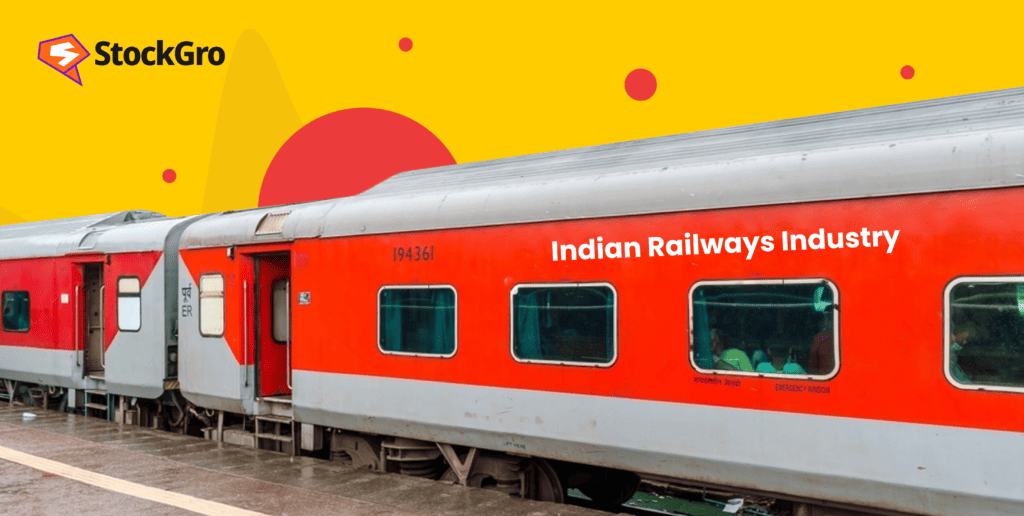
India has various modes of transport today, but there is always something special about train travel. Do you agree?
Especially when travelling with a large group, there is no better way to travel than a train. Train journeys have been popular in Indian households for a long time now. Most of us have fond memories associated with trains – Whether playing with toy trains when we were kids, train journeys during summer vacations, or Bollywood classic love stories in the train.
But do you know the Indian railways, which is so dear to us, is one of the most significant pillars of the Indian economy? Read further to learn the history and growth of railways and their contribution to the economy.
What does the railway sector in India include?
The railway sector in India covers all activities related to transportation through rail. It includes passenger trains, goods trains and all other forms, along with infrastructure, monitoring and development of trains, tracks, signals, etc.
Indian Railways, a statutory body under the Government of India, monitors the railway sector in the country.
You may also like: What does the EV boom mean for auto stocks?
History and development of railways in India
The initial talks about building railway lines in India began in 1832. The first railway line, the Red Hill Railroad, began operating in 1837. It was built in Chennai under the then-British General Authur Cotton to support the movement of granite within the state.
Which company started the first railway service in India?
Madras Railway Company, established in 1845, was one of the first railway construction companies in India. It initially aimed to connect more cities with Madras (now Tamil Nadu), then expanded to connecting inter-states, starting from a line between Madras and Bombay.
Until 1853, all the railway lines in India were built to serve the transportation of goods from one city to another. These goods were mostly construction materials, like granite and other stones, for building dams and other projects. Some of these railway tracks were removed after the completion of such projects, and they do not exist today.
The first passenger railway line began operations in 1853. It was operated by the Great Indian Peninsula Railway and ran from Mumbai to Thane. The railway line was 34 km long and had 400 passengers on its first ride. Gradually, multiple railway lines were built across the country.
Growth of railways
After constructing railway lines to connect different cities, the government started introducing various train developments.
- In 1951, fans and lights were made mandatory in all compartments. In the same year, sleeping coaches were introduced.
- The first air-conditioned train was introduced in 1956, from Howrah in West Bengal to Delhi.
- In 1986, technological advancements started seeping into the railway industry with the introduction of computerised tickets. In 1990, the railway industry set up the first self-printing ticket machine (SPTM) in Delhi. SPTMs helped passengers print their tickets without waiting for assistance from agents at the railway station.
- 1988 saw the first express train in India from Delhi to Jhansi, the Shatabdi Express. Shatabdi continues to be one of the fastest kinds of trains in the country, today.
- The industry went one step further to improve computerised booking by introducing the CONCERT system – Country-wide Network of Computerised Enhanced Reservation and Ticketing. The CONCERT system, introduced in 1996, allowed users to book tickets from anywhere to anywhere.
- In 2000, the Indian Railway’s official website IRCTC (Indian Railways Catering and Tourism Corporation) was launched. To date, this website, acts as the one-stop solution for all railway-related bookings. It allows users to book tickets, order food in trains, track trains, check train schedules and routes, etc.
Importance of Indian railways to the economy
Railways have been one of the essential factors contributing to the growth of the Indian economy. It facilitates the movement of goods and people from one place to another.
With railway lines connecting rural and urban areas, the development of rural areas has become easier. More people from rural areas can travel to cities for work and other requirements. Railways have been instrumental in a large way, in bridging gaps between rural and urban populations in India.
Railways are also known for the number of job opportunities it provides for the citizens of India. It has the credit of being the single largest employer in the country and the 8th largest employer in the world. As of March 2022, Indian Railways had over 12 lakh employees.
Also read: Financing your next car purchase? India’s auto finance sector and lenders
Contribution of railways to the Indian economy
- Indian Railways is the fourth-largest railway network in the world after the USA, Russia and China.
- Indian railways had a revenue of ₹240,000 crores in FY 2022-23. With a track length of 126,366 km, it has 7,335 stations nationwide. The industry has over 13,000 passenger trains and over 9,000 freight trains, running every day.
- The sector is currently focussing on electrifying the entire railway network, i.e., using electric power to induce force in the movement of trains. This change is expected to result in an annual saving of $1.55 billion. India also aims to become the largest green railway (Zero carbon emission) network in the world.
- 6,089 railway stations in the country have Wi-Fi facilities.
- As of 2031, the number of passengers on railways annually is expected to reach 12 billion, and the quantity of freight is expected to touch 8 million tonnes.
- The Indian Railways expects to contribute 1.5% to the country’s GDP. The Union Budget of 2023, had the highest capital of $29 billion allocated to railways.
Amrit Bharat stations
The Amrit Bharat is a government scheme introduced by Prime Minister Narendra Modi on 06 August 2023. It is currently under the supervision of the Railway Minister Ashwini Vaishnaw.
The scheme aims to develop 1275 existing stations in the country. The development includes improving waiting areas, washroom facilities, lounges, lifts and escalators, kiosks selling local products and more. The government has set aside a fund of over ₹24,000 crores towards this initiative.
Vande Bharat train
Vande Bharat is the new-age train facility introduced in India, in 2019. Until recently, Indian Railways focussed primarily on safety and connectivity, but less on speed and comfort. Vande Bharat is an initiative in that direction to provide users with comfortable, fast and safe trains. These trains try to travel between two cities within 10 hours, making this a day service train.
As of September 2023, the country has 34 Vande Bharat Express trains and India aims to have 400 trains in the next three years.
Also Read: Textile industry in India – The foundation of fashionable clothing trends
Railway stocks in India
Below are some popular stocks across different segments of the railway industry:
| Sector | Name | NSE share price | NSE market cap (₹ crore) | BSE share price | BSE market cap (₹ crore) |
| Finance – NBFC | IRFC | ₹76.60 | ₹100,104.76 | ₹76.58 | ₹100,078.62 |
| Online Services | IRCTC | ₹749.55 | 59,964.00 | ₹749.55 | ₹59,964.00 |
| Construction – Infrastructure | Rail Vikas Nigam Ltd. | ₹171.15 | ₹35,685.12 | ₹171.20 | ₹35,695.54 |
| Railway Wagons | TITAGARH | ₹1,002.60 | ₹12,750.17 | ₹1,002.60 | ₹12,750.17 |
| Engineering – Industrial Equipments | BEML | ₹2,457.05 | ₹10,232.26 | ₹2,454.00 | ₹10,219.56 |
| Railway Wagons | Texmaco Rail | ₹154.50 | ₹5,922.58 | ₹154.30 | ₹5,914.91 |
Bottomline
While some people refer to agriculture as the backbone of the Indian economy, few others consider railways as the backbone. Nevertheless, railways are one of the most important sectors as they help in the movement of people and goods, reducing gaps and increasing connectivity.
The Indian railway sector is undoubtedly among the top contributors to the economy, with all the employment opportunities and revenue it provides to the nation.

